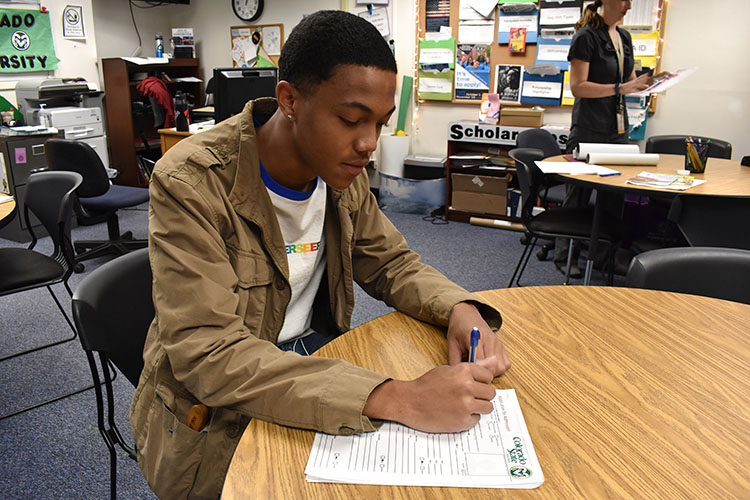
Spartan Kajuanee Ector fights the pressure of college while filling out an application. photo by AJ Domagala
College stress is an everlasting problem for teens, but there are ways to combat it.
On September 18th, a group of Thomas Jefferson students accompanied students from other high schools to Colorado State University (CSU) for a day of touring and introduction to college life. Once students arrived at CSU, they gathered for a speech by some of the admission counselors about how the college wants to diversify and how they’re trying to improve their culture. They spent the day seeing what CSU has to offer in terms of clubs, programs, and community centers for multiple ethnicities. The university had no shortage of resources to get students involved. “There’s a lot of communities you can join and be a part of,” said senior Litzy Alamilla. The trip was set up to advertise the campus to students of course, but there were plenty of other benefits students gained from visiting the campus.
For many, the prospect of college becomes something to dread rather than to look forward to. It starts to seep into the rest of their lives and can affect the student in many other areas. “I get stressed out really easily now cause I’m afraid I might not make it to college, to my dream,” explained senior Jose Vara Sedeno. College is perceived as such a milestone for young adults that the idea of not achieving it is sometimes seen as an absolute failure. The negative perceptions surrounding college stem from multiple factors, but a major source is simply uncertainty. The path to college can be a complicated one, dealing with multiple applications, scholarships, financial aid, and plenty of fees. It’s not easy for a student who is also balancing school, extracurricular activities, and sometimes even a job to manage. It’s a lot to keep track of and it’s hard to feel that one knows everything that is needed. However, students have tools available to them to help combat this stress.
Going on field trips to colleges such as CSU gives students a chance to see what they want in a campus, how much they can expect to pay, and if college is the right choice for them at all. “The benefit of a college campus visit honestly can’t be overstated,” said Sophie Vogel, TJ’s advisor at the Future Center. While they might not be able to answer every single question a student may have, just being there can give someone a sense of relief, since they know that they’re making a step towards their future. “Just look into actual other colleges, try to educate myself on where I’m gonna go, try to limit the stress,” advised Sedeno. Making even the smallest advancement can take some weight off a student’s shoulders. Taking steps like filling out one scholarship application, asking a few questions at the Future Center, or touring a campus can help. Even if a student feels as if they’re too late to get started, there’s always the helpful staff at TJ to guide them.
It’d be quite a task to find a student these days who hasn’t had a breakdown or two from the stress of college. It’s a huge milestone for teenagers, presented to them as early as middle school and they’re pressed to begin the process as soon as they can or else they might be left behind. The pressure and stress put on these young adults goes as far to begin affecting their personal lives. Some are able to seemingly escape the rollercoaster of negativity that is the path to college, but they are a lucky few. After high school, a higher education is presented as the next step for young adults to make in their lives, and in many areas it’s not treated as a choice. By placing college on this pedestal, it causes stress rather than encouraging those who choose to pursue it. Students instead fear failing, and it’s almost inescapable. However, there are resources and ways for students to cope with these negative feelings. A great way to cope is to take that first step, for a student to prove to themselves that they’re working towards their goal. If they do something, even if it’s as small as looking at a college’s website and learning something new, it can ease a worried conscience. Sadly, the overwhelming stress and anxiety seem to come with the teenage package whether or not one decides to pursue a higher education or join the workforce. Fortunately, no one is alone in this process; the staff members and students are all on this road together.